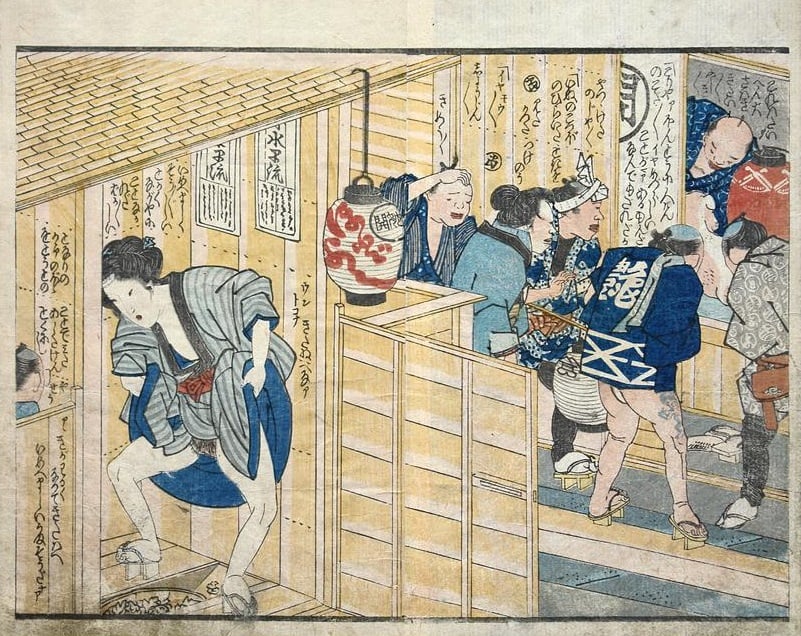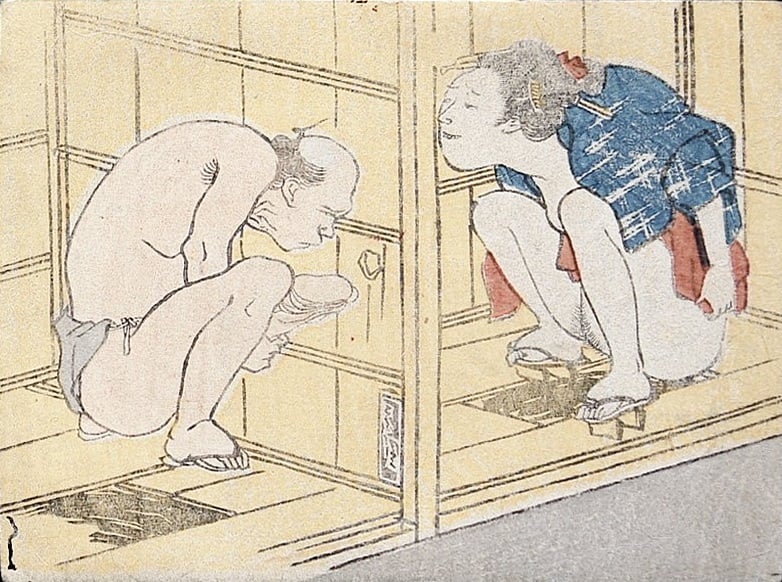Voyeurism within shunga was a beloved subject among many ukiyo-e artists. A sub-theme within voyeurism is that of aroused men peeking on peeing beauties. Although rare, there are some appealing examples like the ones described below.

‘Peeking man behind a fence watching a peeing beauty near a stream‘ (c.1800) from the series ‘Treasure Room of Love (Ehon takara gura)‘ by Kitagawa Utamaro

Kitagawa Utamaro (1753-1806) is among the five greatest ukiyo-e masters. His refined portrayal of female beauty is virtually unmatched. At the end of his career his work suffered from an artistic decline except for..
(1753-1806)
Peeping Tom
A peeping Tom is peeping through a tiny hole in a bamboo fench while jerking off fiercely. He is looking at a peeing beauty squatting near a stream. Below you can find another impression of this design.

Another impression from the series ‘Treasure Room of Love (Ehon takara gura)‘

‘Peeing woman near stream‘ (c.1835) from the series ‘Hana no miyakoji‘ by Utagawa Kunisada

Below you can check out the sensual images of a rare complete book series by Utagawa Kunisada. The title is ‘ Aki no Nanakusa (The Seven Flowers of Autumn)’ and the year of production is 1832. Size (book..
(1786-1865)
Peasant Girl
Erotic image of a peasant girl urinating in a stream. She is being peeped by a horny country lad who is sitting behind a stack of rice

In the Edo period, one of the driving forces of the economy was the rice production. Rice planting happened (and still happens) in the spring, cultivation in the summer, and harvest in the fall. The Japanese style of..
straw.

´Bizarre peep show´ (c.1827) from the series ´Hiyaku mon futari furisode´ by Utagawa Kuniyoshi

Although I dived deep into my shunga library (which lacks very few books on the subject) and also thoroughly researched the internet about the ehon (book) below, I unfortunately could not find much background..
(1797-1861)
Animal Sex Show
In this rather bizarre image by Kuniyoshi we can see a woman who is being spied on, by a man in the other room, when she is using the toilet. In the background an excited crowd have gathered watching some kind of secret animal sex show. One of the male spectators sports a tattoo

Depictions with tattoos in ukiyo-e shunga appear since the mid-eighteenth century but not in earlier hand-painted works. The men wearing tattoos represented the underworld of criminal gangs ( yakuza ) and highway..
on his leg.

‘Peeing woman in bathroom‘ (c.1825) from the series ‘Hyakki yagyo‘ by Utagawa Kunisada
Subtle
Another scene with a peeing beauty in a toilet only this time we, the viewer, are the actual voyeurs. A subtle hint by the artist to his male audience. Like many of the other themes within shunga
Shunga, a genre within ukiyo-e displaying the erotic secrets of ancient Japan. These prints where commonly created by using woodblock printing.
, Kunisada mastered all of them.
There’s also a toy print (shikake-e) version of this design including a door that can be closed.

‘Close of peeing woman‘ (c.1860) from an unknown member of the Utagawa school
Not directly representing the theme of this article but this very rare (first time I ever came across this kind of theme in seventeen years) design makes, like in the previous design, us the voyeur. The same applies to this ancient erotic picture from the 1920s…

Vintage B&W picture ‘Girl peeing in the forest‘ (c.1960s)
Sexual Organs
The reason for the popularity of this subject in shunga may simply be that it provides a convenient occasion and excuse for depicting the sexual organs exposed, but it is more likely that the intention was to show they have another function – and also, perhaps, to illustrate that we are all human, with no reason to be ashamed of such things.

‘An aroused male voyeur peeking at a peeing woman in the other room through a tiny hole in the wallof a public toilet‘ (c.1860) attrib. to Kawanabe Kyosai

The phenomenal Meiji artist Kawanabe Kyosai (1831-1889) who was born to a samurai family after that class had lost its power and influence, was famous for using his art as an instrument of political protest against..